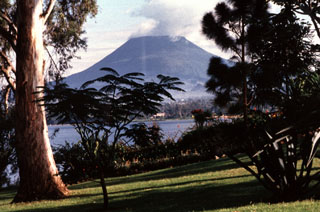Report on Nyiragongo (DR Congo) — June 1982
Scientific Event Alert Network Bulletin, vol. 7, no. 6 (June 1982)
Managing Editor: Lindsay McClelland.
Nyiragongo (DR Congo) Fountaining feeds new lava lake
Please cite this report as:
Global Volcanism Program, 1982. Report on Nyiragongo (DR Congo) (McClelland, L., ed.). Scientific Event Alert Network Bulletin, 7:6. Smithsonian Institution. https://doi.org/10.5479/si.GVP.SEAN198206-223030
Nyiragongo
DR Congo
1.52°S, 29.25°E; summit elev. 3470 m
All times are local (unless otherwise noted)
Lava fountaining began 26 June in Nyiragongo's central crater and by 7 July a lava lake covered the crater floor. No activity had been reported at Nyiragongo since the lava lake drained on 10 January 1977. On 26 and 27 June, two 5-10 m-high lava fountains were observed at the bottom of the crater. By 30 June, only one fountain was active, feeding a very small lava pool. However, when a geologist climbed to the crater rim 7 July, a lava lake about 1/2 km across covered the crater floor. In the center of the lake was a domical lava fountain 30-50 m high and 150 m in diameter. The fountain and the rim of the lake were bright orange, a color similar to that seen during periods of vigorous fountaining before 1977. About 1/3 of the lake was covered by a fissured black skin. Based on comparisons with known pre-eruption features in the crater, the lake level was estimated to have risen 100-150 m between 26 June and 7 July. Most of the lava seemed to be entering the lake from below, but a very small amount of lava was emerging from a 10-m-diameter vent in the N wall of the crater, about 50 m above the lake surface. This vent had apparently been more active a few days earlier. From Goma, 17 km to the SSW, a glow was still visible over the crater 13 July. Earthquakes felt during the night of 4-5 July shook furniture and formed fissures in old houses in Goma.
Geological Summary. The Nyiragongo stratovolcano contained a lava lake in its deep summit crater that was active for half a century before draining catastrophically through its outer flanks in 1977. The steep slopes contrast to the low profile of its neighboring shield volcano, Nyamuragira. Benches in the steep-walled, 1.2-km-wide summit crater mark levels of former lava lakes, which have been observed since the late-19th century. Two older stratovolcanoes, Baruta and Shaheru, are partially overlapped by Nyiragongo on the north and south. About 100 cones are located primarily along radial fissures south of Shaheru, east of the summit, and along a NE-SW zone extending as far as Lake Kivu. Many cones are buried by voluminous lava flows that extend long distances down the flanks, which is characterized by the eruption of foiditic rocks. The extremely fluid 1977 lava flows caused many fatalities, as did lava flows that inundated portions of the major city of Goma in January 2002.
Information Contacts: M. Krafft, Ensisheim.

